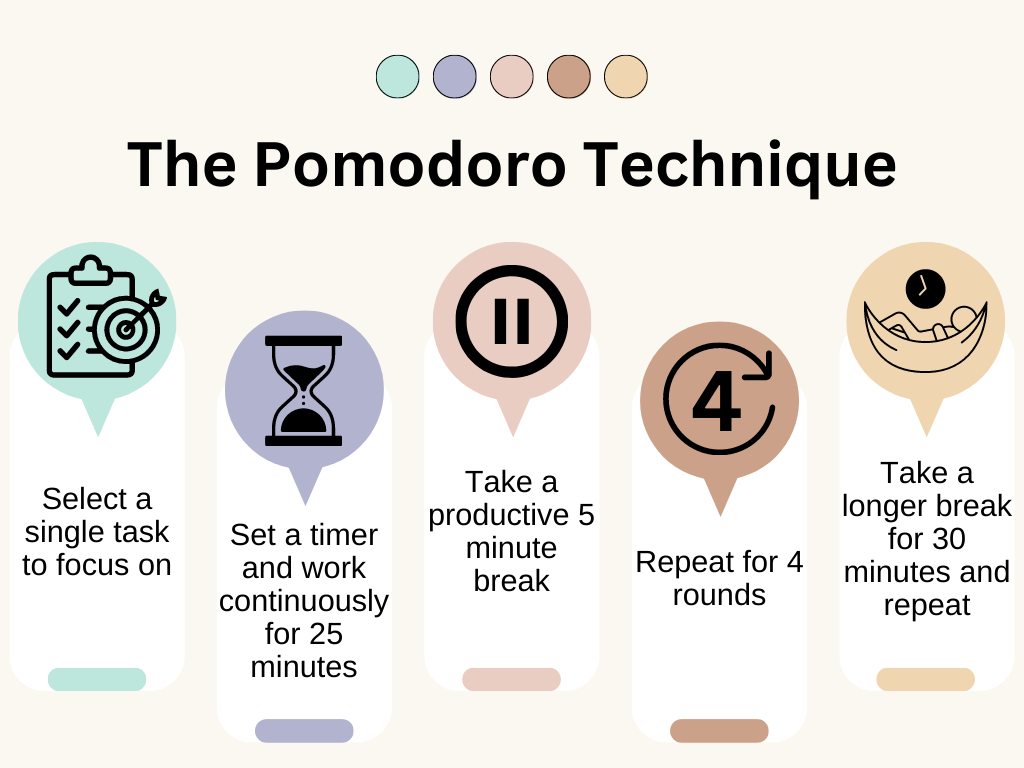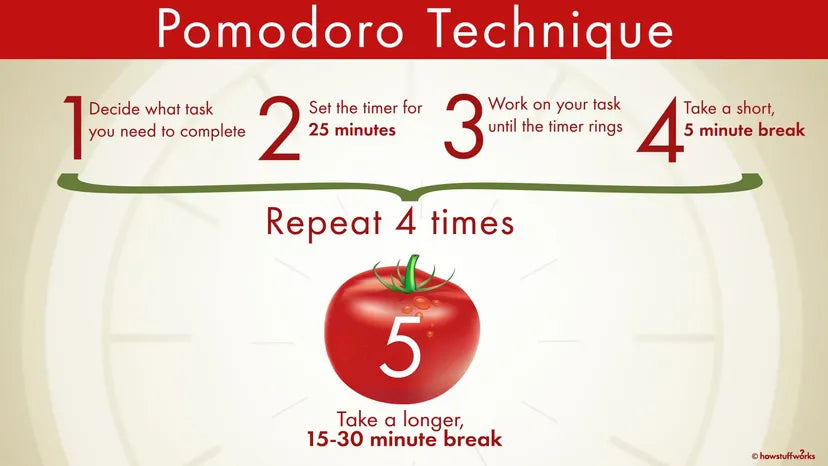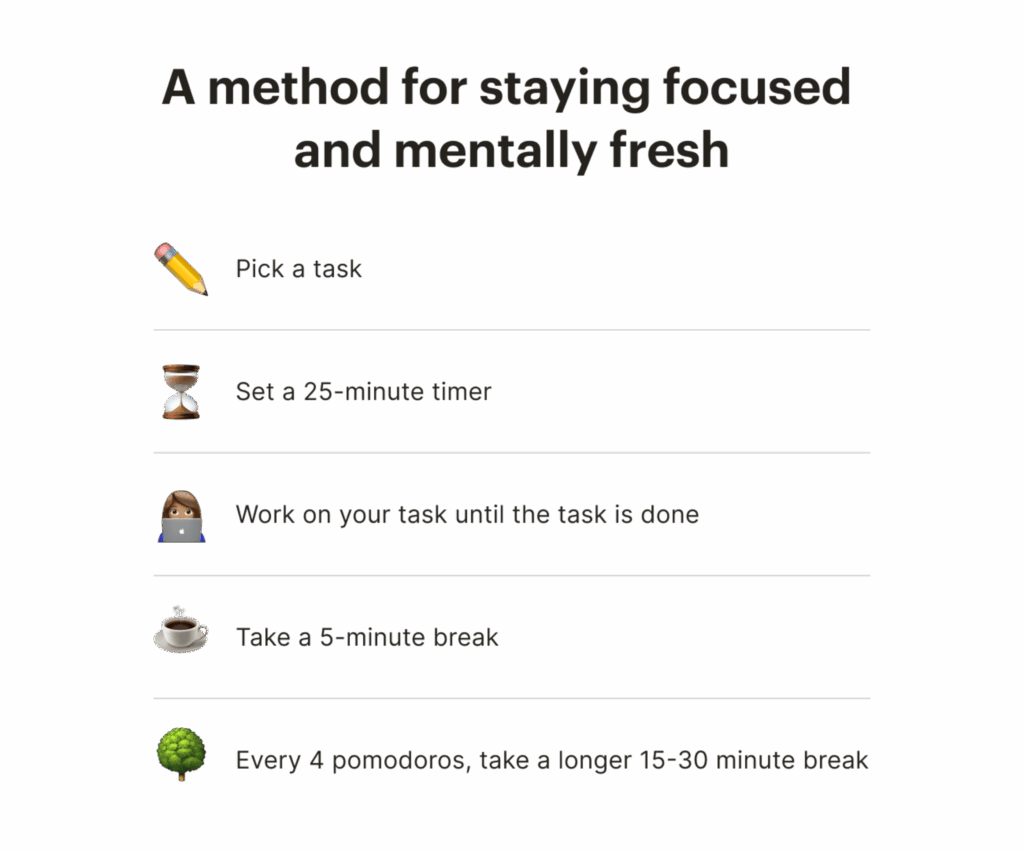Do you ever find yourself staring at a screen, mindlessly scrolling, or getting lost in a sea of tabs when you should be tackling that important project or studying for a crucial exam? In today’s hyper-connected world, maintaining focus and battling constant distractions feels like an uphill battle. We all crave productivity, but often feel overwhelmed by endless to-do lists and the struggle to get started. What if there was a simple, yet incredibly powerful, time management method that could transform your workflow, boost your focus, and significantly improve your efficiency? Enter the Pomodoro Technique, a revolutionary approach designed to help you conquer procrastination and achieve deep work.
What Exactly is the Pomodoro Technique?
At its heart, the Pomodoro Technique is a time management method developed by Francesco Cirillo in the late 1980s. Feeling overwhelmed by his studies, Cirillo used a tomato-shaped kitchen timer (hence “Pomodoro,” the Italian word for tomato) to break his work into focused, manageable intervals. He discovered that these short bursts of intense concentration, punctuated by deliberate short breaks, dramatically improved his ability to focus and sustain productivity.
The core idea is beautifully simple: you work in focused 25-minute increments, known as “Pomodoros,” followed by a short 5-minute break. After completing four Pomodoros, you take a longer break, typically 15-30 minutes. This structured approach helps train your brain to concentrate for defined periods, reducing the temptation to multitask and giving you regular opportunities to recharge. It’s a system built on the understanding that our brains aren’t meant to sustain intense focus indefinitely; they need regular, intentional breaks to perform at their best.
The 5 Fundamental Steps to Use the Pomodoro Technique Effectively
Implementing the Pomodoro Technique is incredibly straightforward. You don’t need fancy software, just a timer and a commitment to focused work. Here’s how to get started in five simple steps:
- Choose Your Task: Before you even set the timer, decide exactly what you’re going to work on. This is crucial for clear goal setting. Whether it’s writing a section of a report, solving a math problem, or researching a specific topic, be crystal clear about the single task you’re dedicating your next Pomodoro to. Breaking down larger tasks into smaller, actionable steps can be immensely helpful here.
- Set Your Timer for 25 Minutes: Grab your physical timer, open a Pomodoro app, or use an online timer, and set it for precisely 25 minutes. This 25-minute sprint is your Pomodoro. The ticking sound of a physical timer can even create a subtle sense of urgency and awareness, further enhancing your focus.
- Work with Intense Focus: For the next 25 minutes, immerse yourself fully in your chosen task. This means absolutely no distractions. Close unnecessary tabs, silence your phone, resist the urge to check email or social media. If an important thought or idea pops into your head that isn’t related to your current task, quickly jot it down on a notepad (a “to-do later” list) and immediately return to your work. The goal is uninterrupted, deep work.
- Take a Short 5-Minute Break: As soon as the timer rings, stop working immediately. Step away from your desk. Use this short break to stretch, grab a glass of water, walk around, or briefly clear your mind. The key is to genuinely disengage from your task. Do not use this time to check emails or start another demanding activity; this break is for active rest.
- Take a Long Break After Four Pomodoros: After completing four Pomodoros (which means you’ve worked for 100 minutes and taken three short 5-minute breaks), it’s time for a longer, more substantial break of 15-30 minutes. This extended break allows for deeper mental reset and helps prevent burnout. Use this time to have a snack, take a short walk outside, or engage in a relaxing, non-work-related activity. Once this long break is over, you can start a new cycle of four Pomodoros.
“The Pomodoro Technique is a simple yet powerful system that helps you manage distractions, fight procrastination, and achieve deep, focused work by breaking your day into concentrated sprints and intentional breaks.” – AskByteWise Productivity Experts
Why Does the Pomodoro Technique Work So Well? (The Science Behind the Method)
The effectiveness of the Pomodoro Technique isn’t just anecdotal; it’s rooted in several psychological principles that enhance our ability to concentrate and perform. Understanding these can help you better appreciate and leverage the method.
Boosts Focus and Reduces Distractions
The 25-minute timer creates a sense of urgency and commitment. Knowing that you only have a short, defined period to work on a task makes your brain less likely to wander. It’s easier to commit to 25 minutes of intense focus than to an indefinite period of work. This structured approach helps build your “focus muscle,” gradually making it easier to ignore internal and external distractions. By having a clear endpoint, your brain knows it just needs to push through for a short sprint.
Prevents Burnout and Enhances Sustained Productivity
Regular breaks are crucial for maintaining cognitive performance. Our brains can only sustain peak concentration for so long. Trying to power through hours of uninterrupted work often leads to diminishing returns, fatigue, and errors. The Pomodoro Technique’s built-in breaks are a proactive measure against burnout. They allow your mind to refresh, consolidate information, and recharge, ensuring that you return to your task with renewed energy and mental clarity. This leads to more sustainable, high-quality output over the long run and promotes a better work-life balance.
Improves Time Estimation and Planning
By consistently tracking your work in Pomodoros, you start to gain a much clearer understanding of how long tasks actually take. This is invaluable for project management and goal setting. Over time, you’ll be able to estimate with greater accuracy how many Pomodoros are needed for a specific report, a coding session, or a study chapter. This data-driven insight helps you plan your day and week more effectively, making your scheduling far more realistic and achievable.
Fights Procrastination
One of the biggest hurdles to productivity is simply starting. Large, daunting tasks often trigger procrastination because they feel overwhelming. The Pomodoro Technique tackles this head-on by breaking down work into small, manageable chunks. Committing to just one 25-minute Pomodoro is far less intimidating than committing to a massive, undefined project. This smaller commitment lowers the activation energy required to start, effectively tricking your brain into overcoming the initial resistance. Once you start, momentum often carries you forward.
Advanced Tips for Mastering the Pomodoro Technique
While the basic steps are easy, truly mastering the Pomodoro Technique involves refining your approach and adapting it to your unique workflow and challenges.
Tackling Large Tasks
For big projects that can’t be completed in a single 25-minute Pomodoro, the trick is to break them down. Instead of “Write Dissertation,” think “Outline Chapter 1 (1 Pomodoro),” “Research Section 1.1 (2 Pomodoros),” “Draft Introduction to Section 1.1 (1 Pomodoro).” This makes overwhelming tasks feel manageable and ensures each Pomodoro has a clear, achievable objective. This strategy is also excellent for goal setting as it creates a clear path forward.
Handling Interruptions Gracefully
Distractions are inevitable, especially in collaborative environments. The Pomodoro Technique offers a simple strategy: the “Inform, Negotiate, Call Back” approach.
- Inform: Politely let colleagues know you’re in a Pomodoro session and will be available shortly.
- Negotiate: If it’s urgent, quickly assess if you can handle it in a minute or two. If not, negotiate a time to address it after your current Pomodoro or during your next break.
- Call Back: Note down the interruption and address it once your Pomodoro (or break) is complete. The key is to protect your focused time fiercely.
The Art of the Break
Your breaks are just as important as your work periods. Use your 5-minute breaks to genuinely disengage. Get up, walk away from your screen, stretch, look out a window, or meditate briefly. For your longer 15-30 minute breaks, consider a short walk, a healthy snack, or a quick chat with a colleague about non-work topics. Avoid anything that demands cognitive effort or could pull you into a new distraction, like checking social media, email, or news feeds during these short breaks. The goal is active recovery, not mental exertion.
When to Adjust Pomodoro Lengths
While 25 minutes is the standard, it’s not a rigid rule. Some tasks, especially highly creative or deeply analytical ones, might benefit from slightly longer Pomodoros (e.g., 30-40 minutes) to get into a true flow state before a break. Conversely, if you’re feeling particularly unmotivated or easily distracted, shorter Pomodoros (e.g., 15-20 minutes) might be more effective to build momentum. Experiment to find what works best for your individual focus levels and the nature of your work, always keeping the short-break, long-break rhythm intact.
Tracking Your Progress
Keeping a simple log of your completed Pomodoros can be incredibly motivating and insightful. A simple piece of paper or a digital note where you mark an “X” for each completed Pomodoro and a small note on what you accomplished can:
- Show your productivity: Seeing tangible progress is a huge psychological boost.
- Improve estimates: Over time, you’ll better understand how long tasks take.
- Identify patterns: Are you more productive in the morning? Do certain types of tasks drain you faster? This data is key for optimizing your workflow.
Integrating the Pomodoro Technique into Your Daily Routine
The beauty of the Pomodoro Technique is its adaptability. It can be seamlessly integrated into almost any daily routine, benefiting diverse groups from students to seasoned professionals.
For Students: A Powerful Study Method
- Studying for Exams: Instead of cramming for hours, use Pomodoros to break down study sessions. Dedicate 25 minutes to a specific topic, take a break, then switch to another topic or review. This helps with information retention and prevents mental fatigue.
- Writing Essays & Papers: Break down the writing process into smaller chunks: research, outlining, drafting paragraphs, editing. Each can be a few Pomodoros. The structured breaks prevent writer’s block and keep your mind fresh.
- Complex Problem Solving: Tackle challenging problems with focused Pomodoros. If you get stuck, a 5-minute break can often provide the mental space needed for a breakthrough.
For Professionals: Enhancing Project Management & Deep Work
- Project Tasks: Apply Pomodoros to specific project deliverables. If you’re managing a busy project, allocate certain Pomodoros to email, certain ones to coding, and others to team collaboration or meetings.
- Deep Work: Use a block of Pomodoros (e.g., 2-3 cycles) early in the day for your most critical, cognitively demanding tasks before daily interruptions begin. This ensures you make significant progress on what truly matters.
- Email & Communication: Instead of constantly checking email, dedicate specific Pomodoros to managing your inbox. This prevents constant context-switching and allows for more efficient processing.
For Creative Work: Overcoming Blocks
- Brainstorming: Use a Pomodoro for pure, unfiltered idea generation. The timer can push you to keep generating ideas even when you feel stuck.
- Design & Development: Focused sprints for design iterations or coding sessions can help maintain momentum and reduce the overwhelming feeling of a large creative undertaking. The short breaks provide a chance to step back and re-evaluate with fresh eyes.
Tools to Help You Implement the Pomodoro Technique
While a simple kitchen timer is all you truly need, a variety of tools can enhance your Pomodoro experience, offering features like tracking, analytics, and customizability.
- Physical Timers: The classic tomato timer is iconic, but any kitchen timer works. The tactile experience and audible ticking can be a powerful psychological trigger for focus.
- Desktop & Web Apps: Many free and paid applications are available.
- FocusKeeper (iOS/Android): A clean, straightforward app that mirrors the classic Pomodoro timer.
- Toggl Track / Clockify (Web/Desktop/Mobile): While primarily time trackers, they can be configured to integrate Pomodoro cycles, offering robust tracking for workflow analysis.
- Marinara Timer (Web): A simple, no-frills web-based Pomodoro timer that’s quick to use.
- Browser Extensions: Extensions like “Forest” or “Focus To-Do” integrate directly into your browser, often blocking distracting websites during your focused Pomodoros, turning your productivity into a game or growing a virtual tree. This gamified approach can be highly motivating for building consistent habits.
Ultimately, the best tool is the one you’ll use consistently. Start simple, then explore options that add value to your unique needs.
Conclusion: Master Your Time, Master Your Productivity
The modern world is constantly vying for your attention, making focused work a scarce commodity. The Pomodoro Technique isn’t just another time management fad; it’s a proven system for reclaiming your focus, boosting your efficiency, and achieving deeper, more meaningful work. By breaking your tasks into manageable sprints and honoring your breaks, you train your brain, prevent burnout, and consistently achieve your goal setting objectives.
Whether you’re a student drowning in coursework, a professional juggling multiple projects, or simply someone looking to improve their daily productivity, learning what is the Pomodoro Technique and how to use it effectively can be a game-changer. It’s a simple, actionable strategy that empowers you to take control of your time and transform the way you work. Don’t just read about it; commit to trying it today. Your future, more productive self will thank you.
Frequently Asked Questions (FAQ)
Q1: Is 25 minutes too short or too long for a Pomodoro?
A1: The 25-minute duration is a widely tested and effective standard that balances deep focus with the need for regular breaks. However, it’s not set in stone. If you find yourself consistently getting into a flow state quickly and 25 minutes feels too short, you might experiment with 30 or even 40-minute Pomodoros. Conversely, if you struggle with focus, try 15 or 20-minute sessions to build up your concentration stamina. The key is finding a length that maximizes your individual focus without leading to mental fatigue before the break.
Q2: What if I finish a task before the Pomodoro ends?
A2: If you complete your primary task before the 25 minutes are up, you have a few options:
- Review and Refine: Use the remaining time to review your work, check for errors, or add any improvements.
- Overlearn: If it’s a study task, spend the extra time reviewing related material to solidify your understanding.
- Plan Ahead: Use the time to plan your next Pomodoro’s task or organize your workspace.
The crucial point is not to start a new, unrelated task or jump into a break. Stay focused on productive activities related to your work until the timer rings.
Q3: Can I skip breaks if I’m on a roll?
A3: It’s highly advisable not to skip your breaks, especially the short 5-minute ones. While it might feel counterintuitive when you’re “in the zone,” skipping breaks often leads to diminished returns and increased mental fatigue in the long run. Breaks are essential for mental rejuvenation, consolidation of information, and preventing burnout. Think of them as necessary pit stops to maintain peak performance, not interruptions to be avoided. Consistent breaks are a core component of how the Pomodoro Technique effectively boosts sustained productivity.
Q4: What’s the best Pomodoro app or tool to use?
A4: The “best” tool depends on your personal preferences and needs.
- For simplicity and a tactile experience: A physical kitchen timer (like the original tomato timer) is excellent.
- For digital convenience and basic features: Many free web timers (e.g., Marinara Timer) or simple mobile apps (e.g., Focus Keeper) are great starting points.
- For advanced features, tracking, and distraction blocking: Apps like Forest (gamified focus), Focus To-Do (integrates to-do lists), or dedicated time trackers like Toggl Track offer more robust functionality.
Start with the simplest option and only upgrade if you feel a specific feature would genuinely enhance your workflow.
Q5: How long does it take to see results with the Pomodoro Technique?
A5: Many people report noticing improved focus and reduced procrastination within just a few days of consistent practice. However, like any skill, truly mastering the Pomodoro Technique and experiencing its full benefits (like improved time estimation and sustained efficiency) takes consistent application over several weeks or even months. The more you practice, the better you’ll become at identifying and managing distractions, structuring your tasks, and leveraging your breaks effectively.
See more: What is the Pomodoro Technique and How to Use It Effectively.
Discover: AskByteWise.


